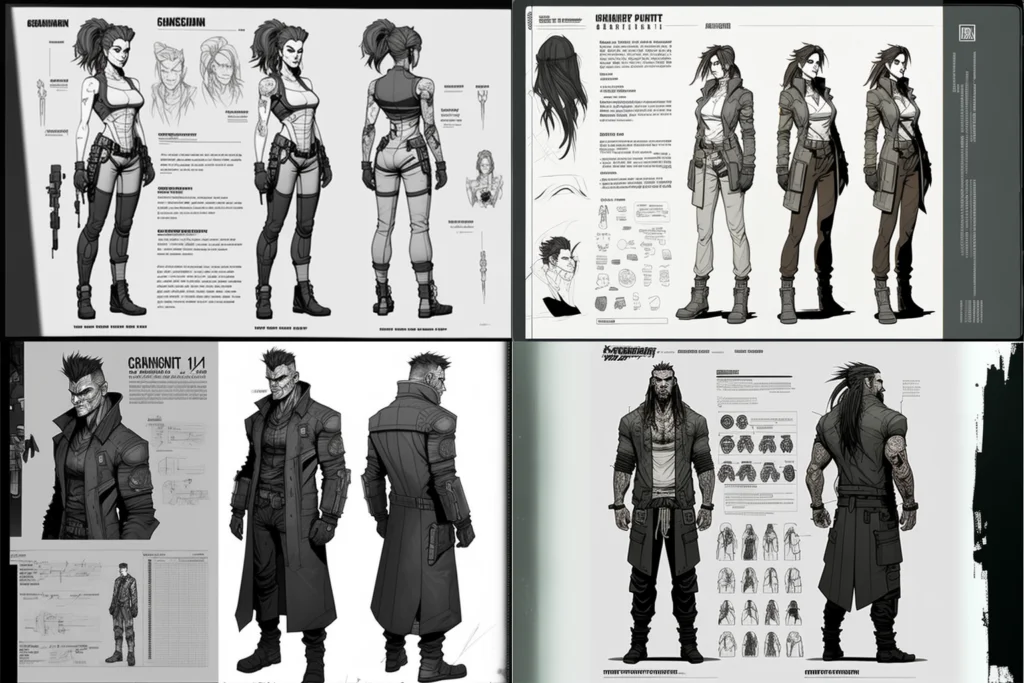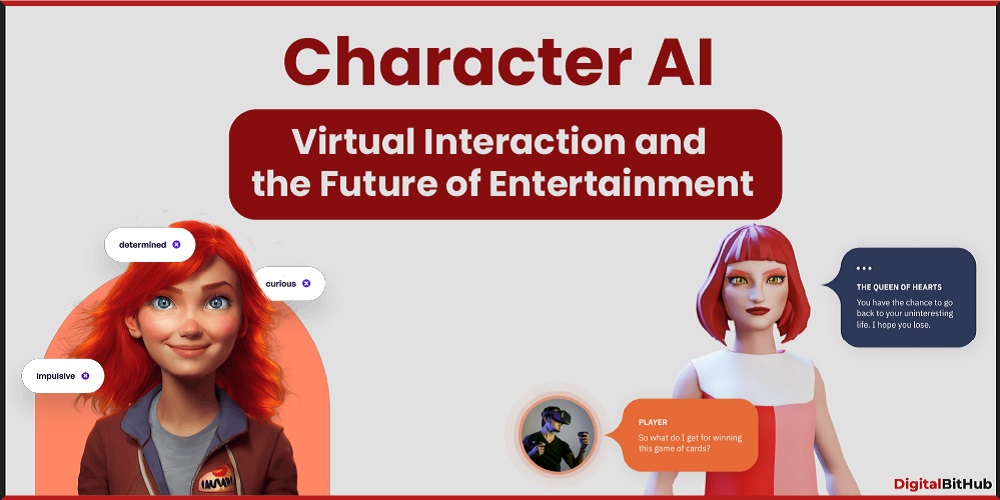AI characters are transforming the digital landscape. These virtual entities are becoming more lifelike and useful.
Imagine interacting with a virtual assistant who understands and responds like a human. AI characters are no longer just science fiction. They are here and evolving fast. These characters can assist, entertain, and even educate us. They are found in games, customer service, and personal assistants.
Their ability to learn and adapt makes them valuable. AI characters are shaping the future of technology. They blend artificial intelligence with human-like traits. This creates engaging and interactive experiences. The rise of AI characters offers exciting possibilities. Let’s explore how they work and why they matter.
What Is An Ai Character?
AI Characters are becoming more common in our digital world. They serve different purposes across various fields. From Conversational Agents in customer service to Virtual Characters in games, they are everywhere. This guide will help you understand what AI Characters are and their types.
Definition And Purpose
Its is a digital entity created using Artificial Intelligence. These characters can interact with users in a human-like manner. They often use Natural Language Processing to understand and respond to human queries.
The purpose of AI Characters varies. Some aim to assist users in tasks. Others focus on providing entertainment. Here are some common purposes:
- Conversational Agents in customer support
- Digital Avatars in virtual meetings
- Interactive Storytelling in video games
Chatbot Technology often powers these AI Characters. It helps them understand and respond to user inputs. Machine Learning also plays a big role. It allows these characters to improve over time.
Types Of Ai Characters
There are several types of AI Characters. Each type serves a different purpose. Here are some common types:
| Type | Description |
|---|---|
| Conversational Agents | Used in customer service to handle queries. |
| Virtual Characters | Appear in video games to interact with players. |
| Digital Avatars | Represent users in virtual meetings or platforms. |
Each type has unique Character Design elements. Conversational Agents focus on understanding language. Virtual Characters focus on visual and interactive elements. Digital Avatars focus on representing real users.

Creation Process
Artificial Intelligence Characters are becoming more popular in today’s digital world. These characters can be found in games, movies, and even customer service. The creation process of these characters involves several steps. This includes concept development, design, and animation. The goal is to make these characters look and act like real people. This guide will explore the steps involved in creating these advanced AI characters.
Concept Development
Concept development is the first step in creating an AI character. This stage involves several key activities:
- Defining the character’s role: What purpose will the character serve?
- Creating a backstory: This helps in making the character more relatable.
- Identifying key traits: What are the character’s personality and behavior?
These steps are essential for developing a strong foundation. A well-thought-out concept is crucial for the next stages. Interactive Characters need a clear purpose and identity. This makes them engaging and effective in their roles.
Here is a simple table to outline the concept development process:
| Steps | Description |
|---|---|
| Defining Role | Determine the character’s main function |
| Creating Backstory | Develop a history for the character |
| Identifying Traits | Outline personality and behavior |
Design And Animation
Design and animation bring the character to life. This stage includes Character Modeling and Ai Animation Techniques. The design process involves creating the character’s appearance. This includes facial features, body shape, and clothing. Virtual Character Design uses software to create these visual elements.
Animation makes the character move and act realistically. Machine Learning In Animation helps in creating natural movements. This includes walking, talking, and facial expressions. Generative Design techniques are used to automate parts of the animation process. This makes it quicker and more efficient.
Ai-Driven Storytelling also plays a role here. It ensures the character interacts with users in a natural way. Conversational agents are an example of this. These agents can understand and respond to human language. They are used in customer service and virtual assistants. The goal is to make the interaction as human-like as possible.
Here is a brief summary of design and animation tasks:
- Character Modeling: Create the visual aspects of the character
- Ai Animation Techniques: Develop realistic movements
- Machine Learning: Improve animation quality
- Ai-Driven Storytelling: Enhance user interaction
Combining these elements ensures the AI character is both visually appealing and functional.
Technology Behind Ai Characters
Artificial Intelligence (AI) characters are transforming the way we interact with technology. These characters are found in video games, customer service, and virtual assistants. They use advanced technologies to understand and respond to human inputs. The technology behind AI characters is complex and fascinating. It includes machine learning algorithms and natural language processing. Let’s dive into the details of these technologies.
Machine Learning Algorithms
Machine learning algorithms are at the heart of AI characters. They enable these characters to learn from data. This learning process involves several steps.
- Data Collection: AI characters need a lot of data to learn. This data includes text, images, and user interactions.
- Data Preprocessing: This step cleans and prepares data for analysis. It involves removing noise and filling missing values.
- Feature Extraction: Important features are extracted from the data. These features help the algorithm understand patterns.
- Model Training: Neural Networks and other models are trained using the processed data. These models learn to make predictions based on input data.
Once the model is trained, it can be used to create intelligent AI characters. These characters can adapt and improve over time. They become more realistic and engaging. In video games, this means smarter opponents. In customer service, it means better responses to queries.
Natural Language Processing
Natural Language Processing (NLP) helps AI characters understand and generate human language. This involves several key techniques.
- Tokenization: Splitting text into smaller units like words or phrases. This helps the AI understand the structure of the text.
- Language Models: These models predict the next word in a sentence. They help in generating meaningful and coherent text.
- Sentiment Analysis: This technique determines the emotion behind a text. It helps AI characters respond appropriately to user emotions.
- Conversational Agents: Chatbots and virtual assistants are examples. They use NLP to hold conversations with users.
Deep Learning techniques are often used in NLP. These techniques allow AI characters to understand context better. They can generate more natural and fluid responses. This makes interactions with AI characters feel more human-like. For instance, in customer service, an AI can understand and respond to complex queries. In games, characters can engage in meaningful dialogues.

Applications In Gaming
Artificial Intelligence Characters (Ai Characters) have become a major part of modern gaming. These virtual characters bring life and depth to game worlds. They enhance player experiences and make games more engaging. Let’s explore the applications of Ai Characters in gaming, focusing on NPC behavior and storytelling enhancements.
Npc Behavior
Non-Player Characters (NPCs) play a crucial role in games. They interact with players and the game environment. Ai NPCs are getting smarter and more realistic. This makes games more immersive and enjoyable.
Here are some ways Ai NPCs improve NPC behavior:
- Realistic Reactions: Ai NPCs can react to player actions in real-time.
- Adaptive Learning: Using machine learning in gaming, NPCs can adapt to player strategies.
- Dynamic Movements: Character animation is smoother and more lifelike with Ai.
- Complex Decision Making: NPCs can make decisions based on multiple factors.
For example, in a stealth game, an Ai NPC can change its patrol route if it notices something unusual. This creates a challenging and engaging experience for players. NPC behavior is essential for game design and player engagement. Procedural generation of NPCs also ensures that each game session feels unique.
Storytelling Enhancements
Interactive storytelling is a key feature of modern games. Ai Characters help in creating dynamic narratives. They can respond to player choices and actions. This adds depth to the game’s story.
Here are some benefits of Ai in storytelling:
- Personalized Narratives: Ai can tailor the story based on player decisions.
- Enhanced Dialogue: Conversations with Ai NPCs feel more natural and engaging.
- Immersive Worlds: Ai helps in creating detailed and interactive game worlds.
For instance, in role-playing games, Ai can create side quests based on the player’s actions. This keeps the player engaged and makes the game world feel alive. Narrative development is crucial for creating memorable gaming experiences. Ai ensures that every player’s journey is unique and engaging.
Role In Movies And Tv
Artificial Intelligence (AI) is changing the film and television industry. Ai Character development has grown rapidly. They are now key players in movies and TV shows. These characters can be animated or even virtual actors. Their presence has brought new life to storytelling. This post explores their roles in movies and TV.
Animated Characters
Animated characters have evolved with the help of AI. These characters now show more emotions and realistic actions. Ai-Generated Animation allows creators to design more complex characters. Here are some ways AI is used in animated characters:
- Machine Learning Avatar: AI can create avatars that learn and adapt.
- Character Design Algorithms: These algorithms help in crafting unique characters.
- Interactive Storytelling: AI enables characters to interact with viewers.
Using AI in animation also reduces production time. It can quickly create detailed backgrounds and scenes. This makes the animation process faster and more efficient. AI can also make characters react in real-time. This adds a layer of realism to animated shows.
In essence, AI has made animated characters more engaging. They can show a range of emotions and respond to their environment. This makes the storytelling process more dynamic and exciting.
Virtual Actors
Virtual actors are becoming more common in the industry. These synthetic actors can perform roles like human actors. They are created using advanced technology and AI. Here are some key points about virtual actors:
| Term | Description |
|---|---|
| Virtual Character Development | Creating detailed and lifelike virtual actors. |
| Digital Persona | Building a character’s identity and personality. |
| Ai-Driven Narratives | AI helps in developing the story around virtual actors. |
| Virtual Reality Characters | Characters that exist in virtual reality settings. |
Virtual actors can play various roles without physical limitations. They can be used in action scenes or perform stunts that are too dangerous for human actors. This opens up new possibilities for filmmakers. Virtual actors can also be reused in different projects. This reduces casting and production costs.
Overall, virtual actors are a valuable addition to movies and TV. They bring flexibility and creativity to the screen. As technology continues to improve, their roles will become even more prominent.

Impact On User Experience
Artificial Intelligence Characters are changing the way we interact with digital platforms. These characters, often seen in games, apps, and websites, enhance user experience. They make interactions more engaging and personalized. By using technologies like Natural Language Processing and Adaptive Learning, these Virtual Characters provide a seamless and intuitive experience for users.
Immersion And Engagement
Artificial Intelligence Characters play a crucial role in increasing user immersion and engagement. They can hold conversations, answer questions, and provide assistance. This makes the user feel they are interacting with a real person.
For instance, Conversational Agents can respond to user queries in real-time. This immediate response keeps the user engaged. Users are more likely to stay on the platform longer. This boosts overall engagement rates.
Here are some ways AI Characters enhance immersion:
- Interactive Storytelling: Users can influence story outcomes through their choices.
- Natural Language Processing: AI understands and responds in a human-like manner.
- Character Development: Characters evolve based on user interactions.
AI Characters are not just about responding to queries. They also provide a sense of companionship. This makes the digital experience more enjoyable and less mechanical. Users feel more connected to the platform.
Personalization Features
Personalized Experiences are another major benefit of Artificial Intelligence Characters. They adapt to the user’s preferences and behaviors. This makes each interaction unique and relevant.
For example, Digital Avatars in learning apps can adapt to the user’s learning pace. This is known as Adaptive Learning. It ensures that the content is neither too easy nor too difficult for the user.
Here are some personalization features offered by AI Characters:
| Feature | Benefit |
|---|---|
| Customized Responses | Replies tailored to user preferences |
| Behavior Tracking | Adapts to user habits and routines |
| Content Recommendations | Suggests content based on user interests |
AI Characters make users feel valued and understood. This improves satisfaction and loyalty. Personalized features also make it easier for users to find what they need. Thus, they save time and effort.
Ethical Considerations
Artificial Intelligence (AI) characters are becoming more prevalent in our daily lives. Virtual Assistants, Chatbots, and other AI-driven entities interact with us regularly. These interactions raise important ethical considerations. One key area of concern is how AI characters might be biased. Another is the impact they have on employment.
Bias In Ai Characters
AI characters are created using algorithms. These algorithms learn from data. If the data is biased, the AI will be biased too. This is known as Algorithmic Bias. It can lead to unfair treatment of certain groups. For example, an AI Virtual Assistant might not understand accents well. This can frustrate users and create a poor experience.
Bias in AI characters can show up in several ways:
- Gender Bias: AI might favor one gender over another.
- Racial Bias: AI might not recognize faces of certain races well.
- Language Bias: AI might struggle with certain dialects.
To reduce bias, developers must use diverse data. They should also test AI characters with different groups. This ensures fair and equal treatment for all users. Ethical AI is crucial for human-computer interaction.
Impact On Employment
Automation and AI characters are changing the job market. Some jobs are becoming obsolete. Virtual Assistants and Chatbots can handle customer service roles. This means fewer jobs for humans in these areas. Machine Learning and Deep Learning technologies are also replacing manual tasks. This leads to job losses in various sectors.
But AI also creates new opportunities. Jobs in AI development, maintenance, and oversight are growing. People need skills in Natural Language Processing and Human-Computer Interaction. These new roles can balance the job losses caused by automation.
Below is a table showing examples of job impacts:
| Sector | Job Loss | New Opportunities |
|---|---|---|
| Customer Service | Call Center Agents | Chatbot Developers |
| Manufacturing | Assembly Line Workers | Automation Engineers |
| Data Analysis | Data Entry Clerks | Data Scientists |
Ethical considerations must guide the integration of AI into the workforce. This ensures a balanced and fair job market for everyone.
Future Trends
Artificial Intelligence (AI) is playing a vital role in creating characters for various platforms. The future of AI characters is bright, with many exciting trends on the horizon. From advancements in technology to new platforms, AI characters are becoming more lifelike and interactive. These trends are shaping the way we interact with virtual characters and enhancing our digital experiences.
Advancements In Ai
Recent advancements in Artificial Intelligence are pushing the boundaries of character creation. Neural Networks and Machine Learning are making characters smarter and more responsive. These technologies allow for more complex character design and behavior.
Some key advancements include:
- Generative Models: These models help in creating unique and realistic characters.
- Natural Language Processing: This enables characters to understand and respond to human language more naturally.
- Conversational Agents: These agents make interactions with characters more engaging and lifelike.
AI characters are also benefiting from AI-Driven Storytelling. This involves using AI to create dynamic and interactive stories. Characters can now adapt their behavior based on user input, making the experience more personalized.
Emerging Platforms
New platforms are emerging that leverage AI for creating and interacting with virtual characters. These platforms are making it easier for developers to integrate AI into their projects.
Some notable platforms include:
- Interactive Media: Platforms that use AI to create engaging and interactive content.
- Virtual Reality: VR platforms that use to create immersive character experiences.
- Gaming: AI is being used to create more realistic and responsive characters in video games.
These platforms are expanding the possibilities for virtual characters. They are enabling more complex interactions and richer storytelling experiences. As these platforms continue to evolve, the potential for AI characters will only grow.
Frequently Asked Questions
What Is An Ai Character?
An AI character is a digital entity driven by artificial intelligence. These characters can mimic human behavior and interact autonomously.
How Do Ai Characters Work?
AI characters use algorithms and machine learning to simulate human-like behavior. They process data and respond accordingly to inputs.
Where Are Ai Characters Used?
AI characters are used in video games, virtual reality, customer service, and more. They enhance user engagement and experience.
Can Ai Characters Learn Over Time?
Yes, AI characters can learn over time. They use machine learning to improve interactions based on past experiences.
Conclusion
AI characters have changed storytelling. They make stories richer and more interactive. Writers can now create deeper characters. Readers enjoy more engaging experiences. AI brings new possibilities to storytelling. It opens doors to creativity. As AI evolves, stories will become even more dynamic.
Embrace this change. Dive into the world of AI characters. The future of storytelling is exciting. Keep exploring, keep creating.

